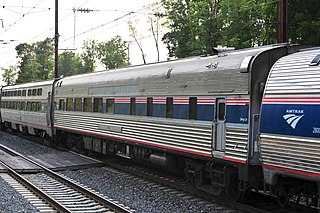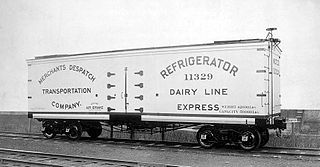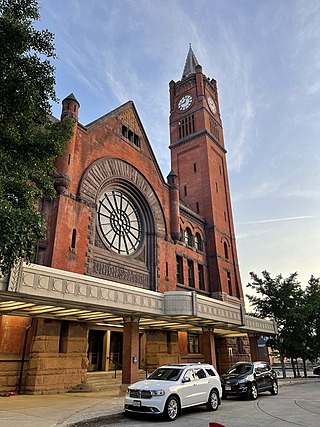
The Beech Grove Shops is a railway maintenance facility in Beech Grove, Indiana, outside Indianapolis. Beech Grove is Amtrak's primary maintenance facility. [1] It also contains a very large freight yard.

The Beech Grove Shops is a railway maintenance facility in Beech Grove, Indiana, outside Indianapolis. Beech Grove is Amtrak's primary maintenance facility. [1] It also contains a very large freight yard.
The shops were originally constructed in 1904–1908 by the Cleveland, Cincinnati, Chicago & St Louis Railway (the "Big Four"), servicing a network stretching across the Midwest into Illinois, Indiana, Michigan, and Ohio. The facility was used as the company's repair shop for steam locomotives and passenger and freight cars. [1]
The Big Four was acquired by the New York Central Railroad (NYC) in 1906, but operated as an independent business until it was formally merged with its owner in 1922. [2] The facility passed to Penn Central Transportation in 1968 when the NYC merged with the Pennsylvania Railroad. Penn Central declared bankruptcy in 1970. [1] Amtrak purchased the facility from the bankrupt Penn Central in April 1975. [3] [4] [5]
On September 20, 2002, an F2 tornado hit the shops, damaging Coach Shop 3, which was going to be torn down after the tornado; it had been used to overhaul Superliner passenger cars until 2000.[ citation needed ]
In the early hours of May 2, 2021, two storage buildings on the site were destroyed by a fire. [6]
The Pennsylvania Railroad, legal name The Pennsylvania Railroad Company, also known as the "Pennsy", was an American Class I railroad that was established in 1846 and headquartered in Philadelphia. It was named for the commonwealth in which it was established. At its peak in 1882, the Pennsylvania Railroad was the largest railroad, the largest transportation enterprise, and the largest corporation in the world.

The New York Central Railroad was a railroad primarily operating in the Great Lakes and Mid-Atlantic regions of the United States. The railroad primarily connected greater New York and Boston in the east with Chicago and St. Louis in the Midwest, along with the intermediate cities of Albany, Buffalo, Cleveland, Cincinnati, Detroit, Rochester and Syracuse. New York Central was headquartered in New York City's New York Central Building, adjacent to its largest station, Grand Central Terminal.

The Empire Service is an inter-city rail service operated by Amtrak within the state of New York in the United States. The brand name originated with the New York Central Railroad in 1967. Trains on the line provide frequent daily service along the 460-mile (740 km) Empire Corridor between New York City and Niagara Falls via Albany, the state capital.

The Broadway Limited was a passenger train operated by the Pennsylvania Railroad (PRR) between New York City and Chicago. It operated from 1912 to 1995. It was the Pennsylvania's premier train, competing directly with the New York Central Railroad's 20th Century Limited. The Broadway Limited continued operating after the formation of Penn Central (PC) in February 1968, one of the few long-distance trains to do so. PC conveyed the train to Amtrak in 1971, who operated it until 1995. The train's name referred not to Broadway in Manhattan, but rather to the "broad way" of PRR's four-track right-of-way along the majority of its route.
The Cleveland, Cincinnati, Chicago and St. Louis Railway, also known as the Big Four Railroad and commonly abbreviated CCC&StL, was a railroad company in the Midwestern United States. It operated in affiliation with the New York Central system.
The Lake Shore and Michigan Southern Railway, established in 1833, and sometimes referred to as the Lake Shore, was a major part of the New York Central Railroad's Water Level Route from Buffalo, New York, to Chicago, Illinois, primarily along the south shore of Lake Erie and across northern Indiana. The line's trackage remains a major rail transportation corridor used by Amtrak passenger trains and several freight lines; in 1998, its ownership was split at Cleveland, Ohio, between CSX Transportation to the east and Norfolk Southern Railway in the west.

Auto Train is an 855-mile (1,376 km) scheduled daily train service for passengers and their automobiles operated by Amtrak between Lorton, Virginia, and Sanford, Florida. Auto Train is the only motorail service in the United States.

The Grand Trunk Western Railroad Company was an American subsidiary of the Grand Trunk Railway, later of the Canadian National Railway operating in Michigan, Illinois, Indiana, and Ohio. Since a corporate restructuring in 1971, the railroad has been under CN's subsidiary holding company, the Grand Trunk Corporation. Grand Trunk Western's routes are part of CN's Michigan Division. Its primary mainline between Chicago and Port Huron, Michigan serves as a connection between railroad interchanges in Chicago and rail lines in eastern Canada and the Northeastern United States. The railroad's extensive trackage in Detroit and across southern Michigan has made it an essential link for the automotive industry as a hauler of parts and automobiles from manufacturing plants.

The Cardinal is a long-distance passenger train operated by Amtrak between New York Penn Station and Chicago Union Station via Philadelphia, Washington, D.C., Charlottesville, Charleston, Huntington, Cincinnati, and Indianapolis. Along with the Capitol Limited and Lake Shore Limited, it is one of three trains linking the Northeast and Chicago. Its 1,146-mile (1,844 km) trip between New York and Chicago takes 281⁄4 hours.
The Whitewater Valley Railroad is a heritage railroad in southeastern Indiana between Connersville and Metamora.

The Michigan Central Railroad was originally chartered in 1832 to establish rail service between Detroit, Michigan, and St. Joseph, Michigan. The railroad later operated in the states of Michigan, Indiana, and Illinois in the United States and the province of Ontario in Canada. After about 1867 the railroad was controlled by the New York Central Railroad, which later became part of Penn Central and then Conrail. After the 1998 Conrail breakup, Norfolk Southern Railway now owns much of the former Michigan Central trackage.

Amtrak's Heritage Fleet consisted of the rolling stock provided to it when it assumed passenger service on commercial railroads. The name was applied to a 1977–1983 program that converted the older, mainly streamlined, cars from steam heating to head-end power. The final Heritage Fleet car was retired in 2019.

The Merchants Despatch Transportation Company was established in 1857 or 1858 by the American Express Company of New York. The entity was reformed as a joint stock trading company on June 1, 1869, with ownership divided among the Cleveland, Columbus, Cincinnati and Indianapolis Railway (CCC&I), the Lake Shore and Michigan Southern Railway, and the New York Central Railroad (NYC), all part of the Cornelius Vanderbilt rail empire.

The Spuyten Duyvil Bridge is a railroad swing bridge that spans the Spuyten Duyvil Creek between Manhattan and the Bronx, in New York City. The bridge is located at the northern tip of Manhattan where the Spuyten Duyvil Creek meets the Hudson River, approximately 1,000 feet (300 m) to the west of the Henry Hudson Bridge.

Martin Luther King Jr. Plaza is the main passenger rail and intercity bus station of Toledo, Ohio.

The Indianapolis Union Station is an intercity train station in the Wholesale District of Indianapolis, Indiana. The terminal is served by Amtrak's Cardinal line, passing through Indianapolis three times weekly.

The Wolverine is a higher-speed passenger train service operated by Amtrak as part of its Michigan Services. The 304-mile (489 km) line provides three daily round-trips between Chicago and Pontiac, Michigan, via Ann Arbor and Detroit. It carries a heritage train name descended from the New York Central.

The National New York Central Railroad Museum is a railroad museum located in Elkhart, Indiana dedicated to the preservation of the New York Central Railroad (NYC).

The James Whitcomb Riley was a passenger train that operated between Chicago, Illinois, and Cincinnati, Ohio, via Indianapolis, Indiana. Originally operated by the New York Central Railroad, it was taken over by Amtrak in 1971. Under Amtrak, it merged with the Chesapeake & Ohio Railway's George Washington to become a Chicago-Washington/Newport News train. In 1977, it was renamed the Cardinal, which remains in operation.

The National Limited was a passenger train that ran between Kansas City, Missouri, and both New York City and Washington, D.C., splitting in Pennsylvania. Amtrak operated the train from 1971 to 1979.
![]() Media related to Beech Grove Shops at Wikimedia Commons
Media related to Beech Grove Shops at Wikimedia Commons
39°43′11″N86°4′40″W / 39.71972°N 86.07778°W